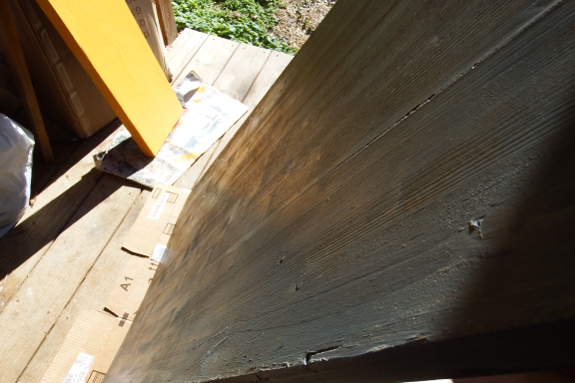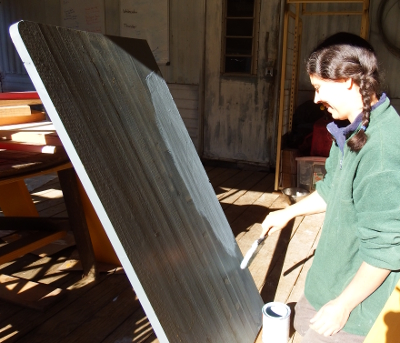
Is primer really necessary with modern paints?

One
of our readers asked why we'd bother to use primer since modern paints
are, at least to some degree, self-priming. I answered that, in my
limited experience, one coat of paint doesn't cut the mustard unless
you're painting over existing wall  paint.
If I'm going to have to apply two coats anyway, why not start with a
can of cheaper primer for phase one?
paint.
If I'm going to have to apply two coats anyway, why not start with a
can of cheaper primer for phase one?
To illustrate my point,
I pulled out our dinner table, which I painted with a
single coat of paint (no primer) a bit less than a year ago. Tables see relatively hard
wear, and eleven months was long enough to rough up the surface so bare
wood was showing through in spots. Time to paint again!
The big question will be
--- which surface looks better at this time next year, the table with
two coats of paint or our
bookcases with one coat of primer and one coat of paint? Let's see
if I remember to report back in January 2018.
Want more in-depth information? Browse through our books.
Or explore more posts by date or by subject.
About us: Anna Hess and Mark Hamilton spent over a decade living self-sufficiently in the mountains of Virginia before moving north to start over from scratch in the foothills of Ohio. They've experimented with permaculture, no-till gardening, trailersteading, home-based microbusinesses and much more, writing about their adventures in both blogs and books.
Want to be notified when new comments are posted on this page? Click on the RSS button after you add a comment to subscribe to the comment feed, or simply check the box beside "email replies to me" while writing your comment.

I love to paint, number # primer is a sealant, which penetrates the wood. Sealing it allows the paint to adheres to the surface. Most paints today says paint and primer. However on bare wood you need to go with primer then paint.
Today's paints with primer do cover surfaces better than before covering marks, scuffs, without a second coat.
As often with such questions, the answer is "it depends"; on what you're painting, which paint you're using and what you are trying to accomplish.
General guidelines for any paint (or glue) are that the substrate should be dry and free of oil/grease and dust. Surface preparation is key to a good paint job. For the best adhesion I tend to de-grease, sand and de-grease again.
Beyond that it very much depends on the substrate. Aluminium generally has bad adhesion without a specialized primer. MDF which is 50% air by volume is like a sponge that can suck the water/solvent out of your paint before it is fully cured. In this case using a sealant saves on expensive paint and makes the paint work better. If you want to smooth a rough surface, that is best done with a filler primer. On soft wood, the underlying wood might fail allowing the paint to flake off. In that case a good epoxy or polyurethane could create a hard surface layer.
And so on and so forth.
Ha! Got you to do an interesting experiment.
What about staining and polyurethaning? I don't think those last as long unless you put beaucoup layers on like I did when I "repaired" a kitchen counter by overlaying it with a board 1/2" deep and waterproofed it with 10 layers of polyurethane. Even then, a hot pot burned a hole through the polyurethane and I had to repair the hole. Because food and such would be in contact with the wood, I didn't want to paint the "new" countertop and I liked the look of the bare wood which is why I opted for polyurethane.